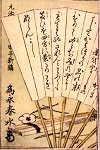
|
|
|
|
|
|
|
|
|
The New Japan With the inauguration of the "enlightened rule" period which the Emperor's progressive regime was then named, Japan emerged from the world of the past into the world of the present. The young Emperor was a fifteen-year-old boy, but he was fortunate in having as advisors a course of the new Japan. Working enthusiastically, they brought about a relatively amalgamation of eastern and western cultures Most of these ministers (many were young) came from the samurai class had been reared in the warrior tradition of responsibility and leadership. Some, who now pushed for the adoption of western methods, had fought for the expulsion of the foreigners in their effort to destroy the Tokugawa Shogunate and restore the Emperor. Now realizing that Japan must play an international role in the world, they were united in looking towards the West. They hoped to adapt western ideas while retaining the values of the East. As one of their spiritual predecessors, Sakuma Shozan, wrote: "eastern ethics and western science.'' Through out the government all efforts were directed toward improving the economy of and building up its military strength. Yet the emphasis on arming, so that the country could negotiate on equal terms with the rest of the world, was not done at the expense of the welfare of the whole country. The government respected the interests of merchants, former feudal estate owners, farmers and samurai. Foreign experts in transportation, defense, agriculture and industry were employed and their progressive methods carefully studied and adopted. A program of social reform was put into motion. Education was made compulsory and, by the end of the Meiji period, attendance in schools stood at ninety-eight per cent. As the young Emperor grew older, he continued to rely on his ministers for advice. Yet in an unobtrusive manner he exerted a moderating influence. Reared in Kyoto in seclusion, be was content to remain in the background but through his dignity and wise counsel, he gave the throne a stature it had not known for hundreds of years. While the country embarked upon new ways, the Imperial Court emphasized traditional ethical values based on Confucian philosophy deeply ingrained in the Japanese character. Inevitably, there were monumental difficulties to overcome in the changeover from feudalism to a central government. And there were minor rebellions and deep disagreements among the ministers. But none of these was allowed to disrupt the march of progress. The government of Japan slowly at first, then with increasing speed earned the respect of the world.
|






